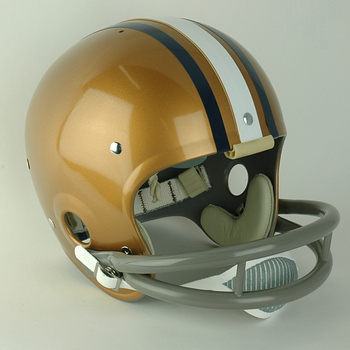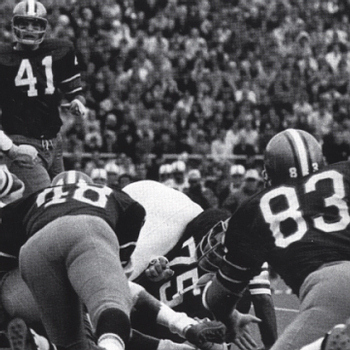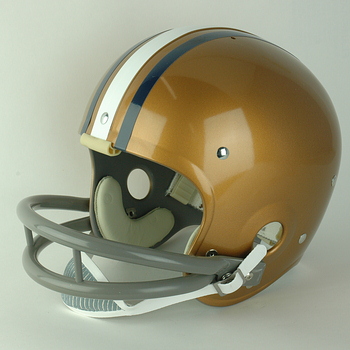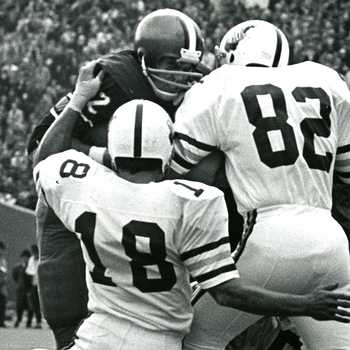

Pittsburgh
1970-72 Panthers
(Authentic Reproduction)






Finally, consecutive year-to-year improvement, however slight, gave hope to the fan base. Many Panthers letter winners, because of the manner in which football and football players were viewed on campus in light of their previous poor play and as “representatives of the establishment,” had stopped wearing their letter jackets. With ‘69’s progress to build upon, attitudes were changing for the better. For the remainder of DePasqua’s tenure, the team wore the same helmet design as the 1969 squad, but removed the right-sided 100 Year decal, leaving the attractive Old gold shell, white one-inch center stripe, one-half-inch Old gold flanking stripes, and one-half-inch Navy blue flanking stripes. The one-and-one-half-inch white identification numerals on the rear of the shell remained too. The 5-1 start held out hope for even more but injuries and the usual tough schedule scuttled that. Despite an upset 36-35 win over rival West Virginia that saw the Jungle Cats roar back from a halftime deficit of 35-8, the team stumbled badly to a 5-5 finish. Quarterback was a group effort shared between vet Dave Havern and John Hogan. Fullback Tony Espositio and halfback Denny Ferris completed their collegiate careers with the former drafted by the Chiefs and Ferris signing with the hometown Steelers as a free agent. The offensive-line was held steady by center Bob Kuziel. Linebacker Ralph Cindrich, outstanding in '69, was out with injury, leaving the heavy work to Joe Carroll and defensive end Lloyd Weston. Defensive back Bryant Salter, despite some of the double-digit poundings the secondary took, remained steady and played well for the Chargers and Redskins through five of his six NFL seasons, shuttling through three teams in his final year.
With fan excitement rekindled for the start of the ’71 season, Coach DePasqua flunked the litmus test in the eyes of many Panthers followers by dropping to 3-8 and losing badly in fifty-plus point pile-ups against three teams, including rival Penn State. A positive highlight came in victimizing Navy 36-35, rebounding from a 35-10 deficit, a similar game to their 1970 heart stopping 36-35 win over West Virginia. The Pro-Set Power I offered little outside running success and was further hampered by the broken collarbone suffered by quarterback Bob Medwid against Syracuse. Stan Ostrowski carried a good deal of the rushing load with center Bob Kuziel keeping order up front. Kuziel was a third round choice of the Saints and played with them for a season before going on to the WFL NY Stars and then moving to the pre-Hog Redskins for six excellent seasons. Soph David Wannsteadt worked his way up to a part-time starting offensive tackle position. Linebackers Joe Carroll and Ralph Cindrich who became one of the best known player agents in the game after a few seasons with the Patriots and Oilers, were the only standouts on a terrible defense that gave up 388 points. As Pitt expanded to an eleven game schedule, DePasqua couldn't stop the descent from 1971's 3-8 record to the 1-10 humiliation of 1972, the school’s first ten-loss season. The lack of speed on both sides of the ball was obvious and the switch to a Wishbone Offense did not resolve any of the underlying issues. The line showed signs of life with Dave Janasek, Lou Cecconi, and Dave Wannsteadt at times stepping up. Ostrowski was the leading rusher on a poor offense. Despite quarterback John Hogan’s four touchdown passes in the fourth quarter of the season finale against Penn State, the 49-27 thrashing was still an embarrassment. Once again it was time for a coaching change and though it was kept under wraps, the Panthers administration and booster organization had very quietly been investigating new head coaching possibilities throughout the ’72 season. Even as a highly respected former Pitt player, Carl DePasqua was out. This time, the arrival of the new head coach would mark an era of excellence on the Pitt campus.
If interested in any of these Pittsburgh helmets please click on the photos below.